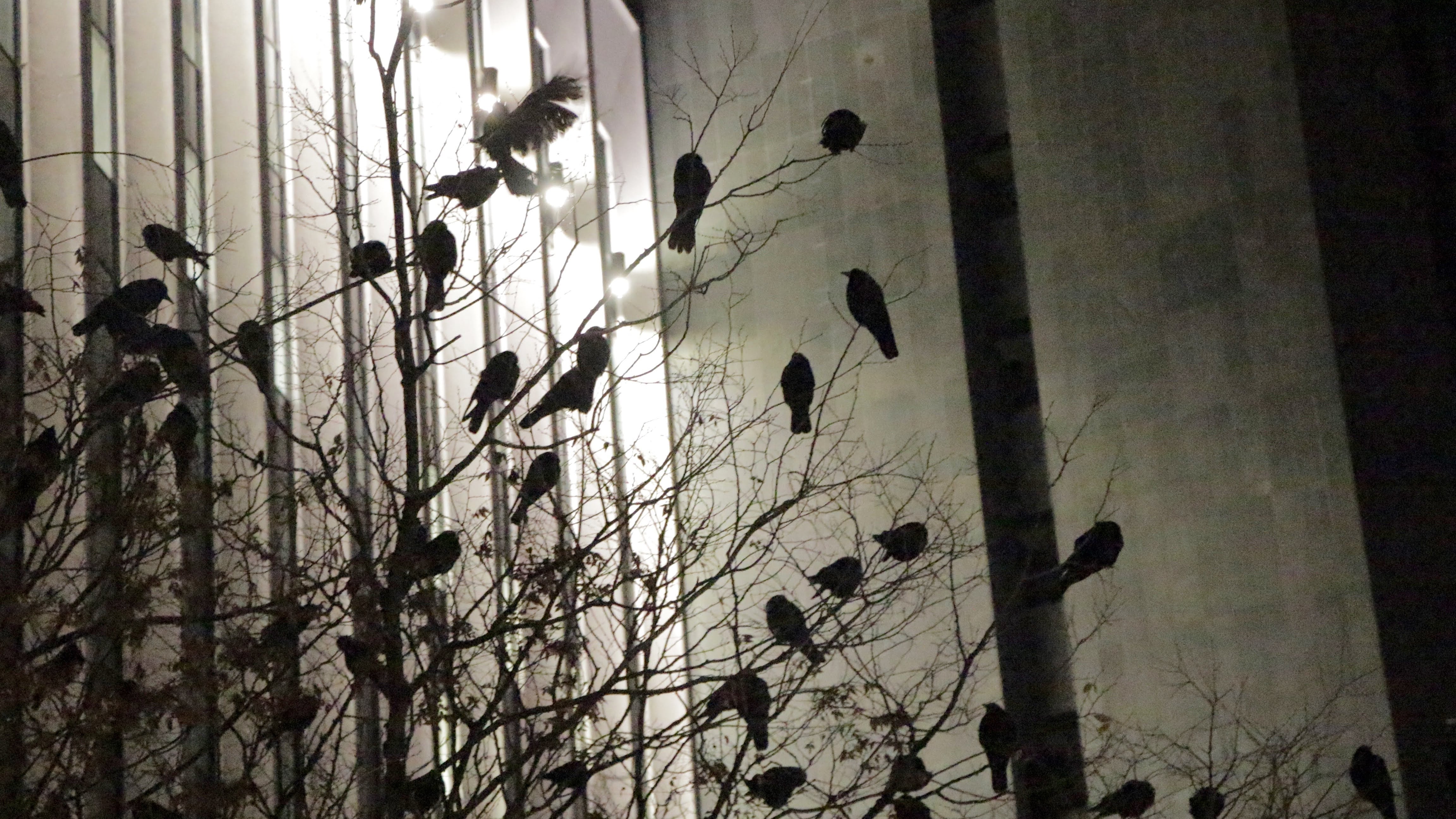On any given winter evening, downtown Portland transforms into a scene from a 19th century gothic novella. Thousands of crows huddle on tree branches and rooftops, cawing and screeching in unison. Since about 2013, increasing numbers of crows have chosen to spend the winter months in Portland, foraging for food during the day and settling in the trees at night.
For Gary Granger, the crow roost is a spectator sport. Granger and fellow amateur corvid enthusiast Rebecca Provorse are co-founders of PDX Crow Roost, a citizen science project that aims to recast Portland's hostile relationship with the dusky bird.
At nightfall, the duo walks 10 miles through the city's center, meticulously counting each visible crow to gather much-needed information on the birds' migratory behavior. (If Granger's name sounds familiar, that's because, on a crow walk earlier this year, he witnessed four teenagers beating a homeless man, called 911, and started a citywide controversy over whether emergency dispatchers were properly responsive.)

Related: A 911 Dispatcher Was Dismissive of a Report of Teenagers Beating a Homeless Man in Downtown Portland.
WW spoke to Granger about the mission of the PDX Crow Roost, the hefty price tag of the city's displacement efforts, and the linguistic con job that is the phrase "murder of crows."
WW: Every year people seem to have something new to say about the number of crows gathering in parks and Portland hot spots. Are there actually more crows downtown, or are we just now realizing they're there?
Gary Granger: The data's not really good on that. The first counts I'm aware of are mine, and in 2017-18, that first winter, the peak number we found was about 7,000. Last year, 2018-19, the peak number was just under 15,000. I don't know if that's really a function of there being more crows coming to Portland, or if that's because my methods for finding the crows downtown have gotten better. I've found them in more places this year than I've ever found them.
How have your methods changed?
I walk a lot farther. The first year, when we would find crows in a 10-block area, and then walk a block or two another direction and not find any more crows, it was like, "OK, we've found them." We presumed they would hang out together.
This year, we've been very diligent about walking a substantial portion of the downtown core. It's about a 10-mile walk. And I've found, in many cases, significant numbers of crows several blocks away from any other crows. So, for example, a couple of weeks ago, there were several thousand crows by the Marriott hotel in the southeast corner of the downtown area, and then there were almost 3,000 crows up by Powell's Books, which is fairly new.
Related: Dead Crows Were "Falling From the Sky" In Northeast Portland Yesterday, May Have Been Poisoned
Where are these crows coming from?
The research that has been done suggests they're coming from probably parts north of us; they're probably not coming from the south. They're probably coming from places that are colder or have less food available in the wintertime. And they could be coming from as far as 700 miles away. These could be crows from Washington, they could be from Canada, they could be from parts farther east.
What's attracting crows to these downtown areas?
A lot of the rural landscape that crows have used to find food has been urbanized, or the farming practices have changed. But also crows are heavily persecuted. They're killed by the thousands, by the hundreds of thousands, in rural areas by shotguns and dynamite. There's still hunting season in rural areas for birds, including crows, and so the crows may be figuring out it's safer in the cities.
There's also a leading theory of the urban heat island—it's warmer in the city. So if a crow spends the night sleeping, trying to stay warm, and it's a couple degrees warmer in the city, than it makes a lot of sense that's where he'd want to be. The final thing is predators. One of the major predators for crows are great horned owls, and there aren't many great horned owls in downtown Portland, probably none.
For a third year, Portland Clean and Safe is releasing hawks in downtown spaces to reduce the presence of roosting crows. Is bird hazing effective?
The stated objective is to temporarily push the crows out of the highest-conflict areas, where people are presumably most upset about crow poop. And it is effective to use hawks.
The thing you need to understand about crows is that they can't see well at night, they don't fly at night, they don't migrate at night ever. So the crows actually can't leave the city physically once it gets dark because they can't fly at night. So they're kind of trapped. If you shoo them away from one block, they're going to go just as far as they have to to feel safe, and then they're going to try to go to sleep again because that's what they're supposed to do when it's dark. What happens is, they get shoved around the city to a different place and there are just as many crows and just as many droppings in the different place. So I'm not a fan.
Related: Portland Is Raptorville USA.
Should we just leave these crows alone?
Yes, in my opinion. All we're talking about is droppings, that's it. We're talking about how much crow poop lands in one place over one period of time and people don't like it. There's no known transmission of any disease from crow poop on the ground to people. But that's not the only opinion, and apparently it's important enough to some people to spend a lot of money. The $60,000 that's being spent on hazing the crows every year, you could buy yourself $10,000 in supplies and equipment and about two-and-a-half full-time people for 26 weeks cleaning up the poop instead of chasing the crows around.
Does the crow need a rebranding of its public image?
That's true. People keep using "murder" to refer to a group of crows, and a group of crows is a flock like any other bird, but this term "murder of crows" got stuck into our lexicon, and that adds this sinister feel to the whole thing. And then we use words like "conflict," there's a "conflict" with the crows. There's no conflict, they just poop.
The crows wouldn't come to a place where we've chased them out over and over again unless that was the best place for them to be. Clearly, they're designed biologically to find the most advantageous place to spend the night, and that's where they're going. And we're saying, "No, no, no, we don't care, go someplace else." And that's kind of what got us to where we are ecologically, in a general sense.

